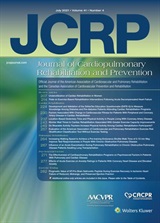Journal: Journal of Cardiopulmonary Rehabilitation and Prevention Authors: Daniel Stevens, Pantelis Andreou, Daniel Rainham Abstract : Purpose: Physical activity (PA) predicts important health outcomes in chronic obstructive pulmonary disease (COPD). In the general population, environmental factors have the potential to influence PA; however, data are limited in this clinical population. Therefore, we sought to investigate associations between the environment and PA, sedentary behavior, and self-rated health in COPD. Methods: Sociodemographic, PA, sedentary behavior, and self-rated health data were collected from a prospective cohort of 418 individuals with COPD (65% female; 58 ± 8 yr), while environmental data were drawn from a national environmental data repository and individually matched to participant postal code. Environmental variables included social and material deprivation, urban form index, surrounding greenness, and air quality (concentrations of air pollution for fine particles, nitrogen dioxide, ozone, and sulphur dioxide). Logistic and multivariate linear regression models were used to investigate the strongest environmental predictors. Results: The models showed a statistically significant negative correlation between PA level and ozone pollution (P = .023; adjusted OR = 0.85: 95% CI, 0.74-0.98). Urban form index was also significantly associated with sedentary behavior (β = 0.113; t value = 1.71; P = .011). Self-rated health was significantly positively correlated with PA level (P = .006; adjusted OR = 2.22: 95% CI, 1.25-3.94), and significantly inversely correlated with sedentary behavior (β = −0.159; t value =−2.42; P = .016). Conclusion: These new data may identify barriers to PA and assist clinicians in the prescription of exercise for individuals living with COPD. doi: 10.1097/HCR.0000000000000628 Last Updated on August 4, 2021


